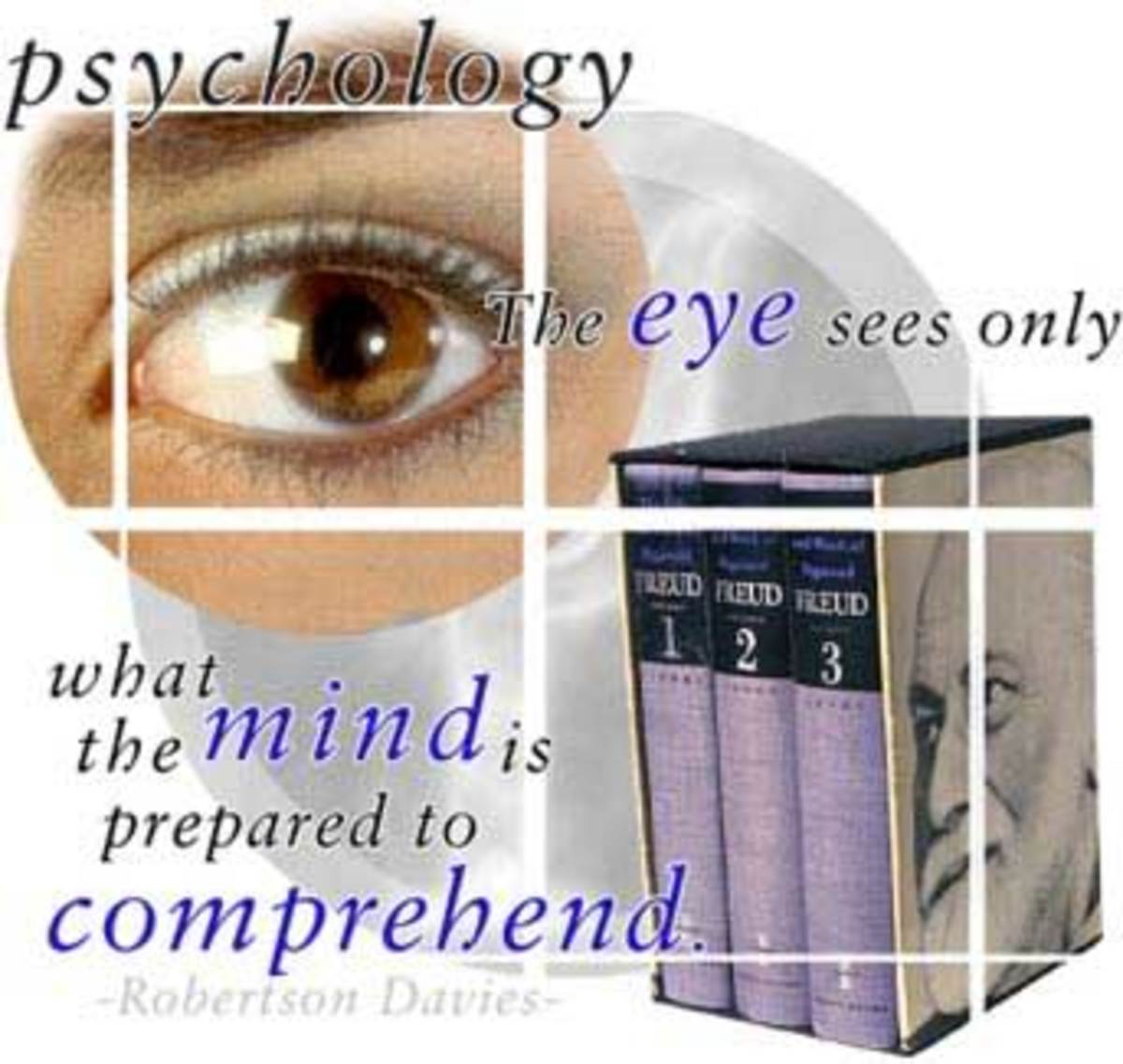Measuring Altruistic Behavior in the College Population
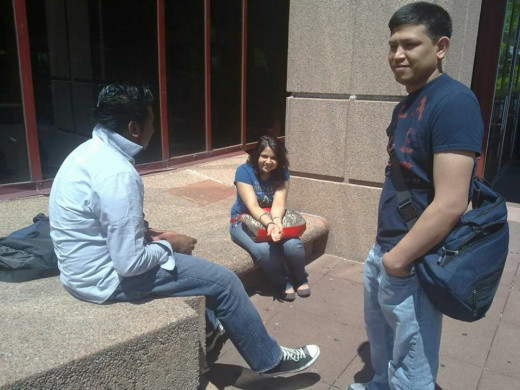
What kind of altruistic behavior would be displayed in one on one situation between strangers?
Altruism is defined as the unselfish concern for others. There are different levels of altruism, from opening a door for somebody to giving up a life to save another. In Christian philosophy, it is memorialized with the story Christ and the sacrifice of his life to save the world. In evolutionary science, there is an open debate to w...hether altruism has a negative effect on heritability, since organisms that sacrifice themselves may not survive long enough to reproduce and pass on their genes. There is a view shared by many that on a macro level our society is becoming more individualistic and less altruistic. What about on the micro level? What kind of altruistic behavior would be displayed in one on one situation between strangers? Are strangers more apt to intervene in situations if asked to do so? What if they are not asked, would they intervene or simply stand by and witness an incident?

Helping behavior also motivates the person to alleviate the guilt associated with not helping the person.
In a research study conducted by Batson and Shaw (1991) they wanted to find out whether the empathy-altruism hypothesis is they reason why people help each other. The hypothesis states that empathic emotion is the motivation and that the ultimate goal is to benefit the person whom empathy is felt, not the person giving the assistance. The authors reviewed over 20 experiments conducted to test and measure helping relationships. They found that the “Results of these experiments have consistently patterned as predicted by the empathy – altruism hypothesis, providing support for a pluralistic model of prosocial motivation that includes altruism as well as egoism.” (p.114). Helping behavior also motivates the person to alleviate the guilt associated with not helping the person. The study concludes that people not only help because they are motivated to be altruistic, but also egoistic because they seek to remove the guilt of not helping.
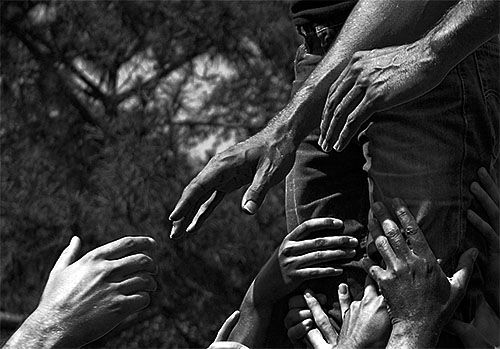
Does the empathy felt by individuals lead to goal specific helping, or just generalized helping behavior?
Does the empathy felt by individuals lead to goal specific helping, or just generalized helping behavior? In an experiment conducted by Dovidio, Allen and Schroeder (1990), they investigated the effect of empathic concern versus helping. The experiment was to determine whether empathy initiates the motivation to be altruistic to alleviate the distress of another person in accordance with the empathy – altruism hypothesis. They also tested whether empathy was motivated by sadness, which in turn causes the individual to reduce that affect by helping as proposed by the negative state relief interpretation. The researchers eventually used 96 women and 96 men from Colgate University as the sample. All the students had begun their introduction to psychology, and were in the process of working on their major. Men and women were assigned to blocks in a 2 (observational set: imagine or observe) x 2 (problem: same or different) x 2 (order of problem presentation) design. The duration of the study lasted over three semesters. The participants were told that they were going to read transcripts or listen to broadcasts about prominent campus personalities. Later, the students were told that they were going to listen to taped broadcast and to form an opinion on the main character of each broadcast. After listening to the broadcast, the students were given two reaction questionnaires to answer. Afterwards the students were asked to listen to another interview, this time they were told to be as objective as possible and not worry about how Tracy Williams interviewed feels. The person interviewed discussed how she needed to find subjects for an interview in order to graduate. After listening to the interview, the students were given another reaction questionnaire and asked to determine how they felt about the Tracy’s problem with data collection.

The final part of the experiment was to have the students read transcripts section of the school newspaper where students advertise. Thirty-two students read the text by Tracy Williams concerning her need for participants in the honors program. Another thirty-two read the text by Tracy concerning her need for participants in the committee program. This was done in order to determine if the perceived need for help was greater for honors programs versus committee programs. After reading the text, both groups were given reaction questionnaires. They were asked to measure the likeability of Tracy, whether she was responsible for her own problems, how much would it cost to help her, etc. A final questionnaire was given to measure the emotional state of the students at the end of the study. Then they were told that they would receive experimental credit and were told that there was an envelope for them. Inside the envelope was a cover letter from the professor directing research. It indicated that Tracy Williams was asking if she could contact the study participants in order to complete her project. She wanted to know how many notices would be distributed in specific buildings throughout the campus. The number distributed would then be recorded.
The results discovered by Dovidio, Allen and Schroeder (1990) found that “subjects in the imagine-set condition reported that they imagined the feelings of the person being interviewed to a greater extent (M = 5.60) than did subjects in the observe-set condition, (M-- 4.09), /7(1,174) = 77.43, p < .001.” (p. 253). They also noted that empathic concern, sadness, and personal distress were all statistically significant as well. The overall results indicated “Imagine-set instructions elicited more empathic concern than did observe-set instructions, and imagine-set subjects helped more than did observe set for the same problem but not for a different problem.” (p.258). Priming led the students to feel more empathy towards Tracy Williams, and as a result they were more inclined to help her. Priming students to be more aware of potential crime could have affected the results of our experiment, causing students to intervene more against property being taken during our study.

What evokes or fails to evoke human sympathy
In another study researching human sympathy and caring, Lowenstein and Small (2007) wanted to find out what evokes or fails to evoke human sympathy . They found several factors that impact sympathy. They are our own personal state, past and vicarious experiences, proximity, in-group/similarity/nationality, newness, and vividness: identifiable victims. In their study, they argued that sympathy is the result of two interactions: sympathy and deliberation. For sympathy they state “One, sympathy, provides the motivational force that drives aid-giving.” (p.121). For deliberation they found “Deliberation is the process that can channel the aid-giving motivated by sympathy in productive directions.” (p.121). Our motivation to watch a strangers property if asked could be due to these two interactions.
A study conducted by Mikulincer, Shaver, Gillath and Nitzburg (2005) sought to identify the conditions that foster compassion and altruistic behavior. They reviewed five experiments that were conducted in America and Israel. The experiments tested the hypothesis that increases in security, reinforced through explicit and implicit priming techniques, increased the likelihood that compassion and altruistic behavior also increased. The five studies documented the effects of two kinds of dispositional attachment insecurity. The study found “that a sense of attachment security allows a redistribution of attention and resources, away from self-protection and towards other behavioral systems, including the care giving system, which operates through such mechanisms as empathy and compassion.” (p.836). They found that people tend to be more compassionate and show empathy when they are primed with certain information and images. For instance, people may be more apt to support charities involving the feeding of starving children after watching a documentary about children starving. If a crime stoppers program had been advertising on campus before our altruism experiment, more people may have intervened against property being taken during our experiment.

Is empathy a source for altruistic motivation?
Is empathy a source for altruistic motivation? Toi and Batson (1982) constructed a 2x2 design to cross manipulate empathy with the ease of escape without helping (easy vs. difficult).
They discovered “The pattern of helping provided clear support for the hypothesis that focusing on the feelings of a person in need leads to altruistic motivation to reduce that persons need.” (p.291). They also found that individuals helped less when escape without helping was easy. This may be the reason why people asked to watch property intervened more than people not asked. People who were not asked to watch property had an “easy” out, they could ignore the fact that property was taken.
Three hypotheses would be tested:
Hypotheses 1: participant’s willingness to help will be dependent on the victim asking them to watch their stuff. The participant should be more willing to stop the thief if they are asked to watch the belongings. Hypotheses 2: participant’s willingness to help will be dependent on the invasiveness of the thief. That is, participants would be more likely to help if the thief actually begins to rummage through the backpack. The interaction hypotheses states that willingness to help experimenter would be greater if asked to watch belongings than if not asked.
Participants and Materials:
One hundred and thirty two students from the campus of the University of Texas at Arlington were observed during this study. No monetary compensation was offered. The materials used were backpack, notebook and a data collection sheet.
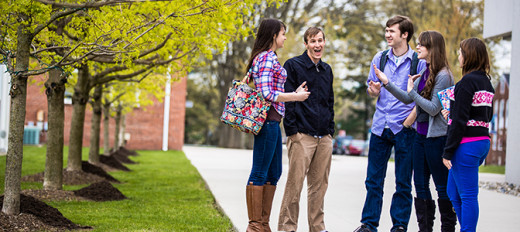
Design and Procedure:
Using a 2x2 between groups randomized design, we studied the effects of altruism by manipulating two variables: asking behavior (ask vs. don’t ask) and level of invasiveness (paper on desk vs. paper in a back pack). The dependent variable (helping behavior) was measured by determining whether or not he participant helped the experimenter. There were four levels of helping: 0 – participant says or does nothing, 1 – mild acknowledgement, 2 – objection, or 3 – strong objection. There were two levels of each independent variable measured. The first IV involved two levels of asking: 1- will you watch my stuff, 2 – say nothing, get up and leave. The second IV measured level of invasiveness: 1 – taking paper from spiral on the desk/table, 2 – taking paper from a spiral in a back pack. A pair of experimenters worked as a team, with one acting as the victim the other acting as the thief. The team would debrief each participant after the collection of data for the four conditions. A standard debriefing script was a read with the victim and thief present in order to demonstrate to the participant that no crime was committed.
From the data collected a one way randomized measure ANOVA with an F ratio was performed.
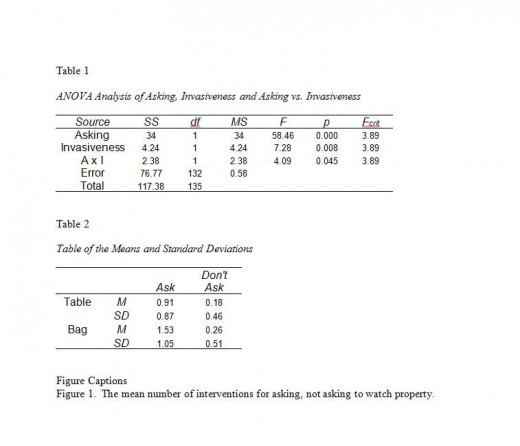
Results
The data in Table 1 shows the results of the ANOVA analysis. A 2x2 between groups randomized subjects measures ANOVA at a .05 significance level was used to analyze the data. The dependent variable was helping behavior with four levels of helping: 0 – participant says or does nothing, 1 – mild acknowledgement, 2 – objection, or 3 – strong objection. Independent variable 1 had two levels of asking: 1- will you watch my stuff, 2 – say nothing, get up and leave. Independent variable 2 measured the level of invasiveness: 1 – taking paper from spiral on the desk/table, 2 – taking paper from a spiral in a back pack.
The ANOVA indicated a significant main effect for the asking condition, F(1, 32) = 58.45, p < .001. This finding supported our hypothesis that people would be willing to watch the victims property if asked. Asking to watch property yielded higher ratings (MM = .91) than not asking (MM = .18). The ANOVA also indicated a significant main effect for invasiveness, F(1, 32) = 7.28, p < .001. This finding also supported our hypothesis that participants would intervene if a thief was invasive and rummaged through the victims backpack. Again, asking to watch property yielded a higher rating on invasiveness (MM = 1.53) than not asking (MM = .26). The ANOVA indicated a significant interaction effect for asking vs. invasiveness, F(1, 32) = 4.09, p < .001. This finding supported our hypothesis that the participants willingness to help the victim would be greater if asked to watch property than if they didn’t ask. The results indicated that students will intervene more if they are asked. They would also intervene if property was being violated by stranger. The data in Table 2 is the table of means and the standard deviation for the data collected. The graph in Figure 1 is the graph of the means of ask, don’t ask and the location of property being taken.
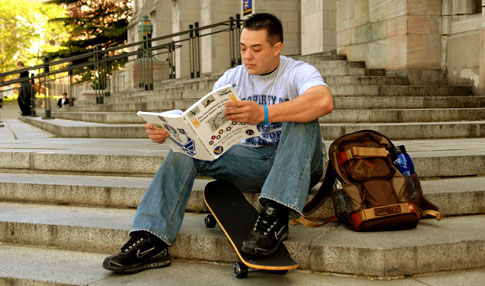
Discuss
The results of the statistical analysis supported the three hypotheses: (a) participants would be more willing to intervene against theft if asked to watch property by the victim; (b) participants would be more willing to help if the thief invades the privacy of the victim by going through their back pack; and (c) participants willingness to help would be greater when the victim asked if they would watch their stuff and the paper being taken was in the back pack. The experiment indicated that on a whole, people would demonstrate altruistic behavior in terms of a simple request. I believe that since a participant was being asked to watch the victim’s property, they are being asked to become a member of the victim’s in-group. By accepting the responsibility to watch property, they have a stake in the outcome of the security of the property. Student’s who weren’t asked to watch property had an easy out; they could ignore the theft that occurred and reduce any possible dissonance they may feel by ignoring that the theft took place. Students were asked to watch items of low value, notebooks, paper, and backpack. I believe the results would have been different if the property had more significant value, like purse, wallet, or cell phone. During the debrief when asked about the experiment, participants felt that the items taken were not of significant value, so some of them did not feel that an intervention necessary. All of the participants did note the appearance of the thief in order to report the individual to the police.
I think the study should have been configured to measure responses to theft and invasiveness by gender. I feel that women may be less apt to watch male’s belongings and intervene against a male thief. I also believe that men are more willing to watch a female’s property more than a male’s property.
© 2010 Augustine A. Zavala


